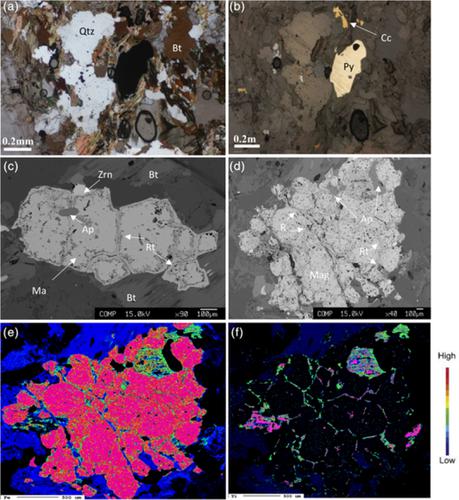当前位置:
X-MOL 学术
›
Resour. Geol.
›
论文详情
Our official English website, www.x-mol.net, welcomes your
feedback! (Note: you will need to create a separate account there.)
Titanium‐in‐biotite thermometry in porphyry copper systems: Challenges to application of the thermometer
Resource Geology ( IF 1.1 ) Pub Date : 2019-12-27 , DOI: 10.1111/rge.12227 Mohsen Rezaei 1 , Alireza Zarasvandi 1
Resource Geology ( IF 1.1 ) Pub Date : 2019-12-27 , DOI: 10.1111/rge.12227 Mohsen Rezaei 1 , Alireza Zarasvandi 1
Affiliation

|
Empirical geothermometer dealing with Ti solubility in the Fe‐Mg biotites was originally proposed for biotites in graphitic, peraluminous metapelites containing ilmenite or rutile that equilibrated roughly at 4–6 kbar. Given that biotites are abundant in the porphyry copper systems, this geothermometer has frequently been used for the determination of magmatic–hydrothermal temperatures in the porphyry copper systems. Common associations of porphyry copper deposits (PCDs), that is, low Al content of biotite, biotite chloritization (causes the biotite to become more magnesian and to lose Ti), and biotite formation by amphibole replacement, as well as disequilibrium, local equilibrium, or re‐equilibration of biotites, especially through potassic alteration, may provide significant uncertainty in the temperatures estimated a by Ti‐in‐biotite geothermometer. In addition, besides the calibration range of thermometer for pressure (400–600 MPa), the temperatures of major sulfide precipitation in PCDs (>~400°C) does not fit with the temperature range of thermometer calibration (480–800°C). Worth noting, as confirmed by fluid inclusion data in the Sarkuh PCD, regardless of presence of mineralogical requirements, obtained temperatures of sulfide mineralization using Ti in biotite thermometer could be overestimated. This may be due to the difference between general conditions of sulfide mineralization and calibration range of Ti in the biotite thermometer for pressure and temperature, as well as the metaluminous nature of biotites in PCDs.
中文翻译:

斑岩铜系统中黑云母钛的测温:温度计的应用挑战
最初有人提出用经验地热仪来处理Fe-Mg黑云母中的Ti溶解度,该方法是针对石墨,钙铝,钙钛矿或金红石中的黑云母中的黑云母,其平衡大致在4-6 kbar。鉴于斑岩铜系统中的黑云母含量丰富,因此该地热仪经常用于测定斑岩铜系统中的岩浆热液温度。斑岩性铜矿床(PCD)的常见关联,即黑云母中Al含量低,黑云母氯化化(导致黑云母变得镁质多并失去Ti),以及通过闪石置换以及不平衡,局部平衡形成黑云母,或重新平衡黑云母,特别是通过钾的改变,钛黑云母地热仪估计的温度可能会提供明显的不确定性。此外,除了压力温度计的校准范围(400–600 MPa)之外,PCD中主要硫化物沉淀的温度(>〜400°C)也不适合温度计校准的温度范围(480–800°C) 。值得注意的是,正如Sarkuh PCD中的流体包裹体数据所证实的那样,无论是否存在矿物学要求,都可能高估了在黑云母温度计中使用Ti获得的硫化物矿化温度。这可能是由于硫化物矿化的一般条件与黑云母温度计中Ti的压力和温度校准范围之间的差异以及PCD中黑云母的金属性质所致。除了压力温度计的校准范围(400–600 MPa)外,PCD中主要硫化物沉淀的温度(>〜400°C)与温度计校准的温度范围(480–800°C)不符。值得注意的是,正如Sarkuh PCD中的流体包裹体数据所证实的那样,无论是否存在矿物学要求,都可能高估了在黑云母温度计中使用Ti获得的硫化物矿化温度。这可能是由于硫化物矿化的一般条件与黑云母温度计中Ti的压力和温度校准范围之间的差异以及PCD中黑云母的金属性质所致。除了压力温度计的校准范围(400–600 MPa)外,PCD中主要硫化物沉淀的温度(>〜400°C)与温度计校准的温度范围(480–800°C)不符。值得注意的是,正如Sarkuh PCD中的流体包裹体数据所证实的那样,无论是否存在矿物学要求,都可能高估了在黑云母温度计中使用Ti获得的硫化物矿化温度。这可能是由于硫化物矿化的一般条件与黑云母温度计中Ti的压力和温度的校准范围之间的差异以及PCD中黑云母的金属性质所致。值得注意的是,正如Sarkuh PCD中的流体包裹体数据所证实的那样,无论是否存在矿物学要求,都可能高估了在黑云母温度计中使用Ti获得的硫化物矿化温度。这可能是由于硫化物矿化的一般条件与黑云母温度计中Ti的压力和温度校准范围之间的差异以及PCD中黑云母的金属性质所致。值得注意的是,正如Sarkuh PCD中的流体包裹体数据所证实的那样,无论是否存在矿物学要求,都可能高估了在黑云母温度计中使用Ti获得的硫化物矿化温度。这可能是由于硫化物矿化的一般条件与黑云母温度计中Ti的压力和温度校准范围之间的差异以及PCD中黑云母的金属性质所致。
更新日期:2019-12-27
中文翻译:

斑岩铜系统中黑云母钛的测温:温度计的应用挑战
最初有人提出用经验地热仪来处理Fe-Mg黑云母中的Ti溶解度,该方法是针对石墨,钙铝,钙钛矿或金红石中的黑云母中的黑云母,其平衡大致在4-6 kbar。鉴于斑岩铜系统中的黑云母含量丰富,因此该地热仪经常用于测定斑岩铜系统中的岩浆热液温度。斑岩性铜矿床(PCD)的常见关联,即黑云母中Al含量低,黑云母氯化化(导致黑云母变得镁质多并失去Ti),以及通过闪石置换以及不平衡,局部平衡形成黑云母,或重新平衡黑云母,特别是通过钾的改变,钛黑云母地热仪估计的温度可能会提供明显的不确定性。此外,除了压力温度计的校准范围(400–600 MPa)之外,PCD中主要硫化物沉淀的温度(>〜400°C)也不适合温度计校准的温度范围(480–800°C) 。值得注意的是,正如Sarkuh PCD中的流体包裹体数据所证实的那样,无论是否存在矿物学要求,都可能高估了在黑云母温度计中使用Ti获得的硫化物矿化温度。这可能是由于硫化物矿化的一般条件与黑云母温度计中Ti的压力和温度校准范围之间的差异以及PCD中黑云母的金属性质所致。除了压力温度计的校准范围(400–600 MPa)外,PCD中主要硫化物沉淀的温度(>〜400°C)与温度计校准的温度范围(480–800°C)不符。值得注意的是,正如Sarkuh PCD中的流体包裹体数据所证实的那样,无论是否存在矿物学要求,都可能高估了在黑云母温度计中使用Ti获得的硫化物矿化温度。这可能是由于硫化物矿化的一般条件与黑云母温度计中Ti的压力和温度校准范围之间的差异以及PCD中黑云母的金属性质所致。除了压力温度计的校准范围(400–600 MPa)外,PCD中主要硫化物沉淀的温度(>〜400°C)与温度计校准的温度范围(480–800°C)不符。值得注意的是,正如Sarkuh PCD中的流体包裹体数据所证实的那样,无论是否存在矿物学要求,都可能高估了在黑云母温度计中使用Ti获得的硫化物矿化温度。这可能是由于硫化物矿化的一般条件与黑云母温度计中Ti的压力和温度的校准范围之间的差异以及PCD中黑云母的金属性质所致。值得注意的是,正如Sarkuh PCD中的流体包裹体数据所证实的那样,无论是否存在矿物学要求,都可能高估了在黑云母温度计中使用Ti获得的硫化物矿化温度。这可能是由于硫化物矿化的一般条件与黑云母温度计中Ti的压力和温度校准范围之间的差异以及PCD中黑云母的金属性质所致。值得注意的是,正如Sarkuh PCD中的流体包裹体数据所证实的那样,无论是否存在矿物学要求,都可能高估了在黑云母温度计中使用Ti获得的硫化物矿化温度。这可能是由于硫化物矿化的一般条件与黑云母温度计中Ti的压力和温度校准范围之间的差异以及PCD中黑云母的金属性质所致。











































 京公网安备 11010802027423号
京公网安备 11010802027423号